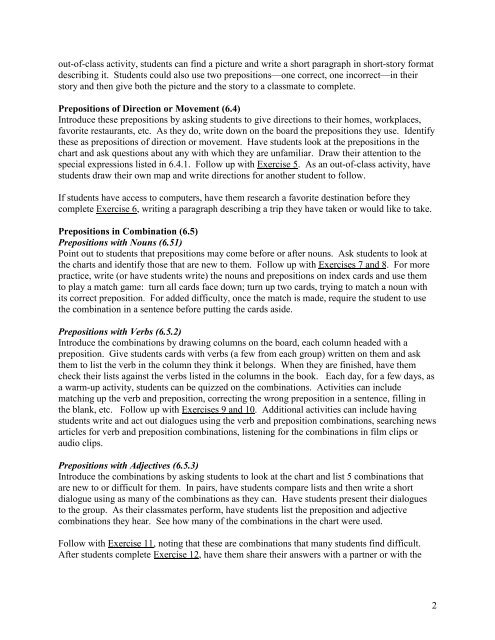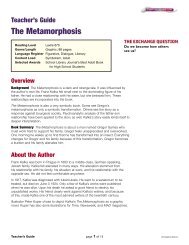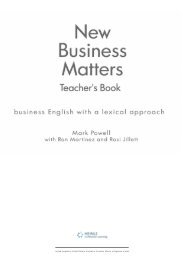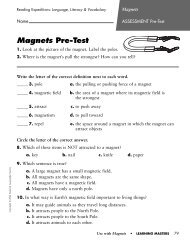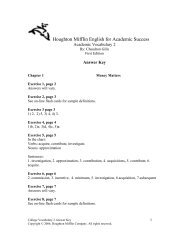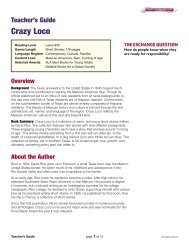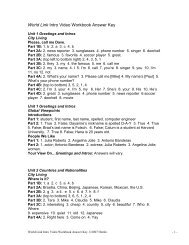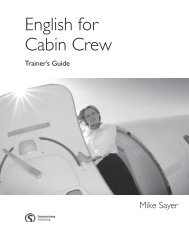Top 20, Great Grammar for Great Writing, First Edition Teaching Notes
Top 20, Great Grammar for Great Writing, First Edition Teaching Notes
Top 20, Great Grammar for Great Writing, First Edition Teaching Notes
You also want an ePaper? Increase the reach of your titles
YUMPU automatically turns print PDFs into web optimized ePapers that Google loves.
out-of-class activity, students can find a picture and write a short paragraph in short-story <strong>for</strong>matdescribing it. Students could also use two prepositions—one correct, one incorrect—in theirstory and then give both the picture and the story to a classmate to complete.Prepositions of Direction or Movement (6.4)Introduce these prepositions by asking students to give directions to their homes, workplaces,favorite restaurants, etc. As they do, write down on the board the prepositions they use. Identifythese as prepositions of direction or movement. Have students look at the prepositions in thechart and ask questions about any with which they are unfamiliar. Draw their attention to thespecial expressions listed in 6.4.1. Follow up with Exercise 5. As an out-of-class activity, havestudents draw their own map and write directions <strong>for</strong> another student to follow.If students have access to computers, have them research a favorite destination be<strong>for</strong>e theycomplete Exercise 6, writing a paragraph describing a trip they have taken or would like to take.Prepositions in Combination (6.5)Prepositions with Nouns (6.51)Point out to students that prepositions may come be<strong>for</strong>e or after nouns. Ask students to look atthe charts and identify those that are new to them. Follow up with Exercises 7 and 8. For morepractice, write (or have students write) the nouns and prepositions on index cards and use themto play a match game: turn all cards face down; turn up two cards, trying to match a noun withits correct preposition. For added difficulty, once the match is made, require the student to usethe combination in a sentence be<strong>for</strong>e putting the cards aside.Prepositions with Verbs (6.5.2)Introduce the combinations by drawing columns on the board, each column headed with apreposition. Give students cards with verbs (a few from each group) written on them and askthem to list the verb in the column they think it belongs. When they are finished, have themcheck their lists against the verbs listed in the columns in the book. Each day, <strong>for</strong> a few days, asa warm-up activity, students can be quizzed on the combinations. Activities can includematching up the verb and preposition, correcting the wrong preposition in a sentence, filling inthe blank, etc. Follow up with Exercises 9 and 10. Additional activities can include havingstudents write and act out dialogues using the verb and preposition combinations, searching newsarticles <strong>for</strong> verb and preposition combinations, listening <strong>for</strong> the combinations in film clips oraudio clips.Prepositions with Adjectives (6.5.3)Introduce the combinations by asking students to look at the chart and list 5 combinations thatare new to or difficult <strong>for</strong> them. In pairs, have students compare lists and then write a shortdialogue using as many of the combinations as they can. Have students present their dialoguesto the group. As their classmates per<strong>for</strong>m, have students list the preposition and adjectivecombinations they hear. See how many of the combinations in the chart were used.Follow with Exercise 11, noting that these are combinations that many students find difficult.After students complete Exercise 12, have them share their answers with a partner or with the2


